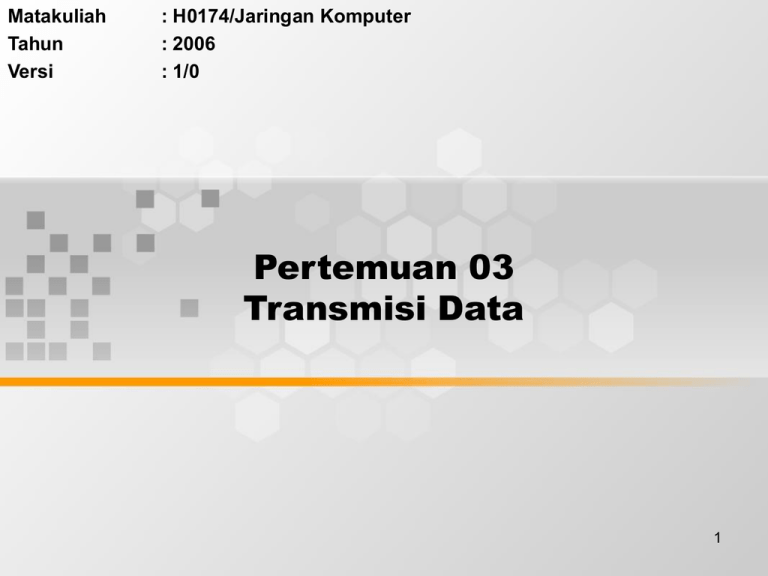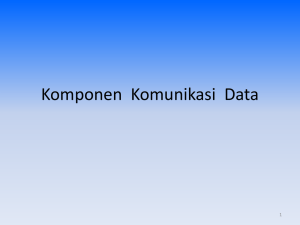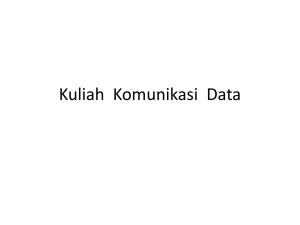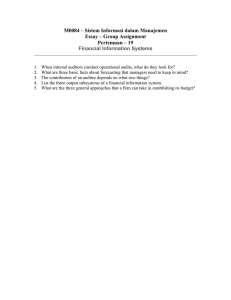Pertemuan 03 Transmisi Data Matakuliah : H0174/Jaringan Komputer
advertisement

Matakuliah Tahun Versi : H0174/Jaringan Komputer : 2006 : 1/0 Pertemuan 03 Transmisi Data 1 Learning Outcomes Pada akhir pertemuan ini, diharapkan mahasiswa akan mampu : • Menjelaskan transmisi data 2 Outline Materi • Mode transmisi • Metode transmisi • Media Transmisi 3 KOMPONEN • Transmitter • Receiver • Medium – Guided medium • twisted pair, optical fiber – Unguided medium • air, water 4 TEKNIK TRANSMISI DATA • MODE TRANSMISI DATA: – PARALEL – SERIAL • ASINKRON • SINKRON • METODE TRANSMISI – SIMPLEX – HALF DUPLEX – FULL DUPLEX • BENTUK FISIK – BOUNDED/GUIDED MEDIUM (KABEL, SERAT OPTIK) – UNBOUNDED/UNGUIDED MEDIUM (MICROWAVE) 5 TEKNIK TRANSMISI DATA • KARAKTERISTIK – MEMBERIKAN LEBAR RENTANG FREKUENSI (BANDWIDTH) YANG DAPAT DILAYANI • GANGGUAN – RANDOM: THERMAL NOISE, IMPULSE, CROSS TALK, ETC – SYSTEMATIC: – ATTENUATION, DELAY, ETC. 6 LST/FASKD/CINQ Paralel Transmission 7 Serial transmission 8 ASINKRON TRANSMISI ASINKRON: – PENGIRIMAN INFORMASI BIASANYA DILAKUKAN PER UNIT DATA ( 5 - 8) BIT – SINKRONISASI DAN RESINKRONISASI DENGAN START/STOP BIT – TIMING HANYA PERLU DIJAGA PADA TIAP UNIT DATA – START/STOP MERUPAKAN OVERHEAD YANG TINGGI – DIGUNAKAN TERUTAMA UNTUK TERMINAL DAN DATA BERUPA KARAKTER 9 LST/FASKD/CINQ Synchronous Transmission 10 TRANSMISI SINKRON TRANSMISI SINKRON – PENGIRIMAN INFORMASI DILAKUKAN PER BLOK DATA DENGAN PERINTAH PENGENDALIAN TERMASUK DALAM BLOK INFORMASI – OVERHEAD SANGAT RENDAH – MEMBUTUHKAN SINKRONISASI YANG RUMIT: • SINKRONISASI BIT • SINKRONISASI KARAKTER/OKTET • SINKRONISASI FRAME 11 Metode Transmisi • Simplex – One direction • e.g. Television • Half duplex – Either direction, but only one way at a time • e.g. police radio • Full duplex – Both directions at the same time • e.g. telephone 12 MEDIA TRANSMISI • UNBOUNDED/UNGUIDED: – GELOMBANG ELEKTROMAGNETIK • GELOMBANG VHF • GELOMBANG UHF • GELOMBANG MIKRO • SPREAD SPEKTRUM • SATELIT • BOUNDED/GUIDED: – KABEL TEMBAGA TWISTED PAIR – UNSHIELDED – SHIELDED – KABEL KOAKSIAL – SERAT OPTIK • MONO MODE • MULTI MODE 13 Guided Transmission Media • Twisted Pair • Coaxial cable • Optical fiber 14 Matakuliah Tahun Versi : H0174/Jaringan Komputer : 2006 : 1/0 Pertemuan 04 Transmisi Data - Lanjutan 15 Learning Outcomes Pada akhir pertemuan ini, diharapkan mahasiswa akan mampu : • Menjelaskan transmisi data 16 Outline Materi • Media • Gangguan 17 Coaxial Cable 18 Coaxial Cable Applications • Television distribution – Antenna to TV – Cable TV + Cable Modem 19 Optical Fiber 20 Optical Fiber Transmission Modes 21 Optical Fiber - Characteristic • Greater capacity (Data rates of hundreds of Gbps) • Smaller size & weight • Lower attenuation • Electromagnetic isolation • Greater repeater spacing 22 Spektrum untuk Communication 23 Transmission Frequencies • 2GHz to 40GHz – Microwave – Highly directional – Point to point – Satellite • 30MHz to 1GHz – Omnidirectional – Broadcast radio • 3 x 1011 to 2 x 1014 – Infrared – Local 24 Bands Band Range Propagation Application VLF 3–30 KHz Ground Long-range radio navigation LF 30–300 KHz Ground Radio beacons and navigational locators MF 300 KHz–3 MHz Sky AM radio HF 3–30 MHz Sky Citizens band (CB), ship/aircraft communication VHF 30–300 MHz Sky and line-of-sight VHF TV, FM radio UHF 300 MHz–3 GHz Line-of-sight UHF TV, cellular phones, paging, satellite SHF 3–30 GHz Line-of-sight Satellite communication EHF 30–300 GHz Line-of-sight Long-range radio navigation 25 Wireless Propagation Signal travels along three routes – Ground wave • Follows contour of earth (up to 2MHz, AM radio) – Sky wave • Amateur radio, BBC world service, Voice of America • Signal reflected from ionosphere layer of upper atmosphere (actually refracted) – Line of sight • Above 30Mhz 26 Satellite Point to Point Link 27 Satellite Broadcast Link 28 Transmission Impairments • Signal received may differ from signal transmitted • Analog - degradation of signal quality • Digital - bit errors • Caused by – Attenuation and attenuation distortion – Delay distortion – Noise 29 Attenuation • Signal strength falls off with distance • Depends on medium • Received signal strength: – must be enough to be detected – must be sufficiently higher than noise to be received without error • Attenuation is an increasing function of frequency 30 Noise • Additional signals inserted between transmitter and receiver • Thermal – Due to thermal agitation of electrons – Uniformly distributed – White noise • Intermodulation – Signals that are the sum and difference of original frequencies sharing a medium 31 Noise • Crosstalk – A signal from one line is picked up by another • Impulse – Irregular pulses or spikes • External electromagnetic interference • Short duration • High amplitude 32



